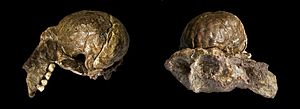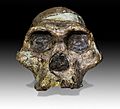Australopithecus africanus facts for kids
Quick facts for kids Australopithecus africanusTemporal range: Pliocene
|
|
|---|---|
 |
|
| Natural endocranial cast (485 cm3) (Sts 60), articulated with a fragmentary skull still embedded in breccia (TM 1511) | |
| Scientific classification | |
| Kingdom: | |
| Phylum: | |
| Class: | |
| Order: | |
| Family: | |
| Genus: | |
| Binomial name | |
| †Australopithecus africanus Dart, 1925
|
|
Australopithecus africanus was an important early human ancestor. It lived in South Africa a very long time ago. Scientists believe it lived between 3.03 and 2.04 million years ago. The discovery of its fossils in 1925 helped us understand more about how humans evolved.
Contents
Discovering Australopithecus africanus
The first Australopithecus africanus fossil was found by a scientist named Raymond Dart in 1925. He discovered a very well-preserved skull of a young australopithecine. This young individual was likely about three to four years old.
The Taung Child
This special skull is known as the Taung Child. It was named after Taung, the place in South Africa where it was discovered. The Taung Child skull is one of the most complete A. africanus skulls ever found. It gave scientists many clues about these ancient relatives.
What Australopithecus africanus Looked Like
Australopithecus africanus had a face that was somewhat "dish-shaped." This means their face was a bit flatter in the middle.
Teeth and Jaw
They had large teeth compared to modern humans. While their front teeth were bigger than ours, their back teeth were especially large. These strong back teeth were used for grinding food. Male A. africanus had a ridge on top of their skulls called a sagital crest. Large muscles were attached to this ridge. These muscles helped support their heavy jaws, which were needed for chewing tough foods.
Related pages
Images for kids
-
Cast of Taung child from the collection of the University of the Witwatersrand
-
Reconstructed skull of Mrs. Ples at the Beijing Museum of Natural History
-
Taung child skull noting raptor-inflicted damage to the eye sockets
See also
 In Spanish: Australopithecus africanus para niños
In Spanish: Australopithecus africanus para niños







